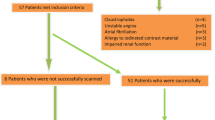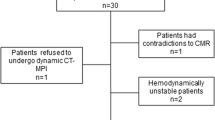Abstract
Objectives
To compare the diagnostic performance and radiation exposure of 128-slice dual-source CT coronary angiography (CTCA) protocols to detect coronary stenosis with more than 50 % lumen obstruction.
Methods
We prospectively included 459 symptomatic patients referred for CTCA. Patients were randomized between high-pitch spiral vs. narrow-window sequential CTCA protocols (heart rate below 65 bpm, group A), or between wide-window sequential vs. retrospective spiral protocols (heart rate above 65 bpm, group B). Diagnostic performance of CTCA was compared with quantitative coronary angiography in 267 patients.
Results
In group A (231 patients, 146 men, mean heart rate 58 ± 7 bpm), high-pitch spiral CTCA yielded a lower per-segment sensitivity compared to sequential CTCA (89 % vs. 97 %, P = 0.01). Specificity, PPV and NPV were comparable (95 %, 62 %, 99 % vs. 96 %, 73 %, 100 %, P > 0.05) but radiation dose was lower (1.16 ± 0.60 vs. 3.82 ± 1.65 mSv, P < 0.001). In group B (228 patients, 132 men, mean heart rate 75 ± 11 bpm), per-segment sensitivity, specificity, PPV and NPV were comparable (94 %, 95 %, 67 %, 99 % vs. 92 %, 95 %, 66 %, 99 %, P > 0.05). Radiation dose of sequential CTCA was lower compared to retrospective CTCA (6.12 ± 2.58 vs. 8.13 ± 4.52 mSv, P < 0.001). Diagnostic performance was comparable in both groups.
Conclusion
Sequential CTCA should be used in patients with regular heart rates using 128-slice dual-source CT, providing optimal diagnostic accuracy with as low as reasonably achievable (ALARA) radiation dose.
Key Points
• 128-slice dual-source CT coronary angiography offers several different acquisition protocols.
• Randomized comparison of protocols reveals an optimal protocol selection strategy.
• Appropriate CTCA protocol selection lowers radiation dose, while maintaining high quality.
• CTCA protocol selection should be based on individual patient characteristics.
• A prospective sequential protocol is preferred for CTCA.


Similar content being viewed by others
Abbreviations
- BMI:
-
body mass index
- CAD:
-
coronary artery disease
- CCA:
-
conventional coronary angiography
- CI:
-
confidence intervals
- CTCA:
-
computed tomography coronary angiography
- DLP:
-
dose length product
- FN:
-
false negative
- FP:
-
false positive
- LAD:
-
left anterior descending coronary artery
- LCX:
-
left circumflex coronary artery
- NPV:
-
negative predictive value
- NS:
-
non-significant
- PPV:
-
positive predictive value
- QCA:
-
quantitative coronary angiography
- RCA:
-
right coronary artery
- TN:
-
true negative
- TP:
-
true positive
References
von Ballmoos MW, Haring B, Juillerat P, Alkadhi H (2011) Meta-analysis: diagnostic performance of low-radiation-dose coronary computed tomography angiography. Ann Intern Med 154:413–420
Mowatt G, Cummins E, Waugh N et al (2008) Systematic review of the clinical effectiveness and cost-effectiveness of 64-slice or higher computed tomography angiography as an alternative to invasive coronary angiography in the investigation of coronary artery disease. Health Technol Assess 12:iii–iv, ix–143
Vanhoenacker PK, Heijenbrok-Kal MH, Van Heste R et al (2007) Diagnostic performance of multidetector CT angiography for assessment of coronary artery disease: meta-analysis. Radiology 244:419–428
Weustink AC, Meijboom WB, Mollet NR et al (2007) Reliable high-speed coronary computed tomography in symptomatic patients. J Am Coll Cardiol 50:786–794
Pugliese F, Mollet NR, Hunink MG et al (2008) Diagnostic performance of coronary CT angiography by using different generations of multisection scanners: single-center experience. Radiology 246:384–393
Taylor AJ, Cerqueira M, Hodgson JM et al (2010) ACCF/SCCT/ACR/AHA/ASE/ASNC/NASCI/SCAI/SCMR 2010 appropriate use criteria for cardiac computed tomography. A report of the American College of Cardiology Foundation Appropriate Use Criteria Task Force, the Society of Cardiovascular Computed Tomography, the American College of Radiology, the American Heart Association, the American Society of Echocardiography, the American Society of Nuclear Cardiology, the North American Society for Cardiovascular Imaging, the Society for Cardiovascular Angiography and Interventions, and the Society for Cardiovascular Magnetic Resonance. J Am Coll Cardiol 56:1864–1894
Einstein AJ, Henzlova MJ, Rajagopalan S (2007) Estimating risk of cancer associated with radiation exposure from 64-slice computed tomography coronary angiography. JAMA 298:317–323
Gerber TC, Carr JJ, Arai AE et al (2009) Ionizing radiation in cardiac imaging: a science advisory from the American Heart Association Committee on Cardiac Imaging of the Council on Clinical Cardiology and Committee on Cardiovascular Imaging and Intervention of the Council on Cardiovascular Radiology and Intervention. Circulation 119:1056–1065
Roobottom CA, Mitchell G, Morgan-Hughes G (2010) Radiation-reduction strategies in cardiac computed tomographic angiography. Clin Radiol 65:859–867
Bischoff B, Hein F, Meyer T et al (2010) Comparison of sequential and helical scanning for radiation dose and image quality: results of the Prospective Multicenter Study on Radiation Dose Estimates of Cardiac CT Angiography (PROTECTION) I Study. AJR 194:1495–1499
Hausleiter J, Martinoff S, Hadamitzky M et al (2010) Image quality and radiation exposure with a low tube voltage protocol for coronary CT angiography results of the PROTECTION II Trial. JACC Cardiovasc Imaging 3:1113–1123
Halliburton SS, Abbara S, Chen MY et al (2011) SCCT guidelines on radiation dose and dose-optimization strategies in cardiovascular CT. J Cardiovasc Comput Tomogr 5:198–224
Sun ML, Lu B, Wu RZ et al (2011) Diagnostic accuracy of dual-source CT coronary angiography with prospective ECG-triggering on different heart rate patients. Eur Radiol 21:1635–1642
Achenbach S, Marwan M, Ropers D et al (2010) Coronary computed tomography angiography with a consistent dose below 1 mSv using prospectively electrocardiogram-triggered high-pitch spiral acquisition. Eur Hear J 31:340–346
Alkadhi H, Stolzmann P, Desbiolles L et al (2010) Low-dose, 128-slice, dual-source CT coronary angiography: accuracy and radiation dose of the high-pitch and the step-and-shoot mode. Heart 96:933–938
Leschka S, Stolzmann P, Desbiolles L et al (2009) Diagnostic accuracy of high-pitch dual-source CT for the assessment of coronary stenoses: first experience. Eur Radiol 19:2896–2903
Sommer WH, Albrecht E, Bamberg F et al (2010) Feasibility and radiation dose of high-pitch acquisition protocols in patients undergoing dual-source cardiac CT. AJR 195:1306–1312
Ertel D, Lell MM, Harig F, Flohr T, Schmidt B, Kalender WA (2009) Cardiac spiral dual-source CT with high pitch: a feasibility study. Eur Radiol 19:2357–2362
Weustink AC, Mollet NR, Pugliese F et al (2008) Optimal electrocardiographic pulsing windows and heart rate: effect on image quality and radiation exposure at dual-source coronary CT angiography. Radiology 248:792–798
Austen WG, Edwards JE, Frye RL et al (1975) A reporting system on patients evaluated for coronary artery disease. Report of the Ad Hoc Committee for Grading of Coronary Artery Disease, Council on Cardiovascular Surgery, American Heart Association. Circulation 51:5–40
Shrimpton P (2004) Assessment of patient dose in CT. http://www.msct.eu/PDF_FILES/Appendix%20paediatric%20CT%20Dosimetry.pdf. Accessed 20 Nov 2008
Begg CB, Greenes RA (1983) Assessment of diagnostic tests when disease verification is subject to selection bias. Biometrics 39:207–215
Hunink MG, Polak JF, Barlan MM, O’Leary DH (1993) Detection and quantification of carotid artery stenosis: efficacy of various Doppler velocity parameters. AJR 160:619–625
Weustink AC, Mollet NR, Neefjes LA et al (2010) Diagnostic accuracy and clinical utility of noninvasive testing for coronary artery disease. Ann Intern Med 152:630–639
Achenbach S, Goroll T, Seltmann M et al (2011) Detection of coronary artery stenoses by low-dose, prospectively ECG-triggered, high-pitch spiral coronary CT angiography. JACC Cardiovasc Imaging 4:328–337
Leschka S, Stolzmann P, Schmid FT et al (2008) Low kilovoltage cardiac dual-source CT: attenuation, noise, and radiation dose. Eur Radiol 18:1809–1817
Yu L, Li H, Fletcher JG, McCollough CH (2010) Automatic selection of tube potential for radiation dose reduction in CT: a general strategy. Med Phys 37:234–243
Leipsic J, Labounty TM, Heilbron B et al (2010) Estimated radiation dose reduction using adaptive statistical iterative reconstruction in coronary CT angiography: the ERASIR study. AJR 195:655–660
Author information
Authors and Affiliations
Corresponding author
Rights and permissions
About this article
Cite this article
Neefjes, L.A., Rossi, A., Genders, T.S.S. et al. Diagnostic accuracy of 128-slice dual-source CT coronary angiography: a randomized comparison of different acquisition protocols. Eur Radiol 23, 614–622 (2013). https://doi.org/10.1007/s00330-012-2663-3
Received:
Revised:
Accepted:
Published:
Issue Date:
DOI: https://doi.org/10.1007/s00330-012-2663-3




